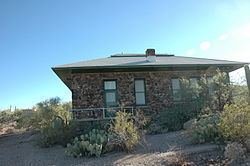Built 1903 Designated NHL December 21, 1965 Area 3.48 km² | NRHP Reference # 66000190 Opened 1903 Added to NRHP 15 October 1966 | |
 | ||
Similar Tumamoc Hill, Sentinel Peak, Arizona‑Sonora Desert Museum, Reid Park Zoo, San Francisco Peaks | ||
Desert laboratory model cannon storm online game ggo
The Desert Laboratory at 1675 West Anklam Road, Tucson, Arizona was founded by the Carnegie Institution in 1903 to study how plants survive and thrive in the heat and aridity of deserts. Beginning in 1906, numerous long term ecological observation areas were set up by Volney Spalding & Forrest Shreve on the 860 acres (3.5 km2) scientific domain of Tumamoc Hill. Nine of these are the world's oldest permanent ecology study quadrats. The facility and staff were key contributors to what is now considered the science of ecology, including participating in the creation of the Ecological Society of America in 1915 and the Ecology journal. Led by Spalding & Shreve, they also contributed innovations in conservation.
Contents
- Desert laboratory model cannon storm online game ggo
- History
- Directors
- Walking up Tumamocs Road
- References
Part of it was declared a National Historic Landmark in 1965., The rest was added in 1987.
History
Acting on the authority of the Carnegie Institution of Washington, Frederick Vernon Coville Botanist of the USDA and Daniel T. McDougal of the New York Botanical Garden chose Tumamoc Hill as the location of the Desert Laboratory in February, 1903. It opened in October of that year.
It is now operated by Tumamoc: People & Habitats, part of The University of Arizona's College of Science.
Directors
Its current director is Michael Rosenzweig
Walking up Tumamoc's Road
The public is welcome to walk up almost to the top of Tumamoc Hill except not from 7:30 AM to 5:30 PM, Mon-Fri. Walkers must stay on the road. Bicycles and pets are not allowed. And the very top of the Hill is an archaeological site where there is no unsupervised entry. Vehicular traffic restricted to authorized persons.
